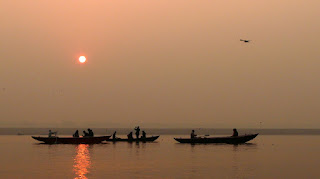


Ganga river at the dawn.
Varanasi was surely one of the most unrealistic place, that we happen to visit during our trip. No wonder Timothy Leary, writer, psychologist and researcher of psychedelic drugs, went to Varanasi to test the effect of LSD on himself.
Varanasi is simply high concentration of absurdity of all life.
The most everyday life of Varanasi is going on on ghats - stairs of the river bank.
If you just walk around the ghats and keep your senses open, you can experience something similar to lucid dreaming.
In one section they are burning bodies. Many men together in the middle of the smoking piles of wood. The smell that comes into your nose is something so familiar - just like smell of sausages grilled on the forest bonfire. At some point the legs fall off the dead body, because there were not in the direct fire. The fire-keeper is putting the legs back into the fire with a stick. A cow is slowly walking into the burning ghat area, looking right, looking left, thinking, thinking and suddenly making everybody around it jump away with its long urine falls. Just little further away, children are playing cricket and flying kites. Then suddenly you hear load sound of barking - two gangs of dogs appear, fighting over the ownership of the ghat area. One of them was arrogant enough to enter into the neighboring ghat. That is not his territory! As you continue the walk on the ghats you soon reach to the beggars section. All corporation is sitting together on the stairs and pointing you with the bowl in their hand. Just next to the river, somebody is washing clothes, somebody is washing himself or a chimpanzee, somebody is getting married. There are yellow-faced people praying in the river. A crowd has gathered together to observe something happening. When you go closer you see a dead body sitting on the chair, men putting her on the boat and two other men making picture together with the white body decorated into yellow flowers. Then you notice a goat dressed in a vest, then a holy man jumping and playing a clown....at some point you just feel need to close your eyes for a moment and open them again to make sure that you have not drifted away into some kind of la-la land....

Big burning ghat



Burning ghat in the background, washing ghat in front

Wood is a great business in Varanasi.
Only the most richest people can afford to be burnt on the bank of Ganga and spread into the river as an ash, in order to become free from the reincarnation circle and reach to eternal heaven.
That is in turn a paradox, because the poorest people and beggars who suffer the most, have to go through the rebirth again and again and again and bear the heavy burden of karma.

Washing ghat

Drying the clothes after washing



People praying. Probably south-Indian tourists.
Women in south India have a habit to dye their faces yellow with turmeric, in order to look more fair.


The holy banks of the holy river Ganga are so holy that even the most holiest activities are done there.

Washing on the bank of Holy river Ganga
Every day about 60 000 people go down to the Varanasi ghats. There are 30 large sewers continuously discharging into the river. Ganga river is so heavily polluted that the water is septic, thus no dissolved oxygen exists. The water has 1,5 million fecal coliform bacteria per 100 ml, whereas the water that is safe for bathing should contain less than 500.
After all these researches, Hindu people still believe that the water is pure, holy and good for divine zip. And sometimes belief is powerful.

Morning tooth brush with the tooth branch

Dogs waiting for bones maybe ?

some kind of ritual, that we had no clue about

washing...

Dead women on her last journey into Ganga.





a holy man, a sadhu

There are all kinds of services on the ghats. One of them is shaving, as according to the Hindu tradition, shaving the head is a sign of mourning.

Little business-women trying to sell children's skin colors for 100 Rupees (200 Rupees is a night in double room)

Beggar's ghat

washing water buffaloes in the river Ganga


Ghat children

Washing....

Washing plates for the restaurant

Ganga.
One side of the river is fully inhabitated and they call it Varanasi, the other river bank is simply cursed.
No local goes there, because bad spirits live there.
The narrow streets of Varanasi are not less hallucinogenic.


pee wall next to the eating place

One of the worst habits of Indians - burning rubbish, sometimes also standing around the fire, warming their hands and breathing in the toxic gases of plastic.
And India has huge burden of plastic rubbish.
But again, what can they do.....Indian waste disposal system is still very underdeveloped.

Entrance to the bakery. Who goes first ?



vegetable market place
In each city of India, that is lying on the banks of the holy Ganga river, every evening is like a big festival - thousands of people gather to see the Ganga closing ceremony, give flowers to Ganga and get a blessing.
The hour long show was quite nice. Seven Hindu priests dancing with incense sticks and candles with the intensive Hindu music in the background.


When enjoying the ceremony, two little dwarfs appeared suddenly , holding their palms upwards...

Some travelers consider Varanasi as one of those Indian cities, that is good to see only once in a lifetime.
For us Varanasi was a psychedelic experience, in a weird way maybe even one of the pearls of India. So, when it will happen that we will be nearby in the future, we would stop by again.
"Varanasi, the holiest Hindu place, where already 5000 years is going on a non-stop hippie festival."
/Timothy Leary/




















